The Middle East has become an increasingly important international hub in recent years, and countries in the region are racing to build new and expand existing airports to meet passenger demand. The Middle East connects major economies in Asia, Europe, and Africa and, along with Asia-Pacific, is expected to account for nearly 60 percent of global air passenger travel by 2040, according to the CAPA – Centre for Aviation. Meanwhile, the Airport Council International estimates that Middle East airports will welcome 1.1 billion passengers by that time, up from pre-pandemic totals of 405 million in 2019.
There are more than 110 airports in the Middle East, and the CAPA – Centre for Aviation reports an additional 155 planned and ongoing development projects worth a combined $209.4 billion. Here is a look at some of the most prominent airport projects in the region.
1. Jeddah Airport City
A key component of Saudi Arabia’s Kingdom Vision 2030, Jeddah Airport City is a four-zone city development project encompassing more than 2 million square meters of land adjacent to the King Abdulaziz International Airport (KAIA) Terminal 1. The new 810,000-square-meter terminal, built in 2019, will allow KAIA to accommodate 45 million passengers per year by 2030. Further expansion efforts will increase KAIA’s passenger capacity to 114 million passengers annually after 2035.
The Haramain High Speed Rail, also opened in 2019, is another central travel hub at the heart of Jeddah Airport City. The high-speed rail connects KAIA to the holy cities of Madinah and Makkah in just 75 and 43 minutes, respectively. It can reach speeds up to 300 km/h and carries roughly 60 million passengers per year. The four Jeddah Airport City zones (Exhibition Circuit, Business District, Fun Zone, and Calm Community) will be built in four quadrants on each side of the Haramain High Speed Rail.
“Jeddah Airport City will introduce a variety of uses, building types, and amenities to create a 24/7 destination at the juncture of KAIA and Jeddah’s evolving urban area, serving the needs of visitors and locals, while evolving Jeddah as a world-class city,” said Sultan Bin Ali Al Harb, chairman of SARH Development Company, which is overseeing the project. “The broad range of uses and amenities will generate significant non-aeronautical revenues and financial returns while improving the competitiveness and branding of KAIA and Jeddah.”
Among other amenities and buildings in the four zones, Jeddah Airport City will house several luxury hotels, 200,000 square meters of office space, multi-family housing, a community mosque, a 20,000-seat arena, the 12,350-square-meter Central Gateway Botanical Gardens, an aquarium, and a health clinic. There will also be pedestrian pathways and a mobility shuttle circuit. Construction of the $4.5 billion project is expected to begin in 2023 and conclude by 2028.
2. Hamad International Airport Terminal Expansion
Expansion plans for the Hamad International Airport in Doha, Qatar, have been ongoing since October 2019. Phase A of the project, which included the construction of a new concourse to link concourses D and E, concluded in November 2022. Phase B commenced in January 2023 and involves the addition of new e-gates, a remote transfer baggage facility, and various passenger amenity areas. Annual passenger capacity is expected to exceed 60 million once the expansion project is finished.
3. Sharjah Airport Expansion
The Sharjah International Airport in the United Arab Emirates (UAE) welcomed 7 million passengers in the first six months of 2023, representing a 24.4 percent increase from the same period the year prior. A $517 million expansion project, expected to be completed by the end of 2026, will increase its annual capacity to 20 million passengers. Sharjah Airport is home to Air Arabia, a preeminent low-cost carrier in the region, and these expansion efforts will allow the airline to increase travel options and routes from markets in East Asia and Europe.
To date, the Sharjah Airport Authority has announced six new flight destinations, including Bangkok (Thailand) and Kuala Lumpur (Malaysia), and three new air cargo destinations: Houston (US), Kigali (Rwanda), and Nashik (India). The airport handled more than 70,000 tons of cargo in 2022.
4. New Airport in Oman’s Musandam Governorate
Oman’s Civil Aviation Authority is overseeing plans for the creation of a new airport in the Musandam Governorate, the northernmost governorate in the country. The new airport will supplant Khasab Airport, which isn’t able to accommodate most international flights due to its mountain location. The $250 million project, expected to be completed by the end of 2026, will feature a pair of runways and a passenger terminal with a 250,000 annual passenger capacity.
5. New Terminal at Kuwait International Airport
A $4.36 billion expansion project at the Kuwait International Airport, once completed, is expected to double annual passenger capacity from 6 million to 13 million. Four new departure gates were recently added to the airport, while a 710,000-square-meter second passenger terminal is expected to be completed by 2025. It will be the first LEED Gold-accredited passenger terminal building in the world. The expansion program also involves the addition of a third runway and a new control tower.

